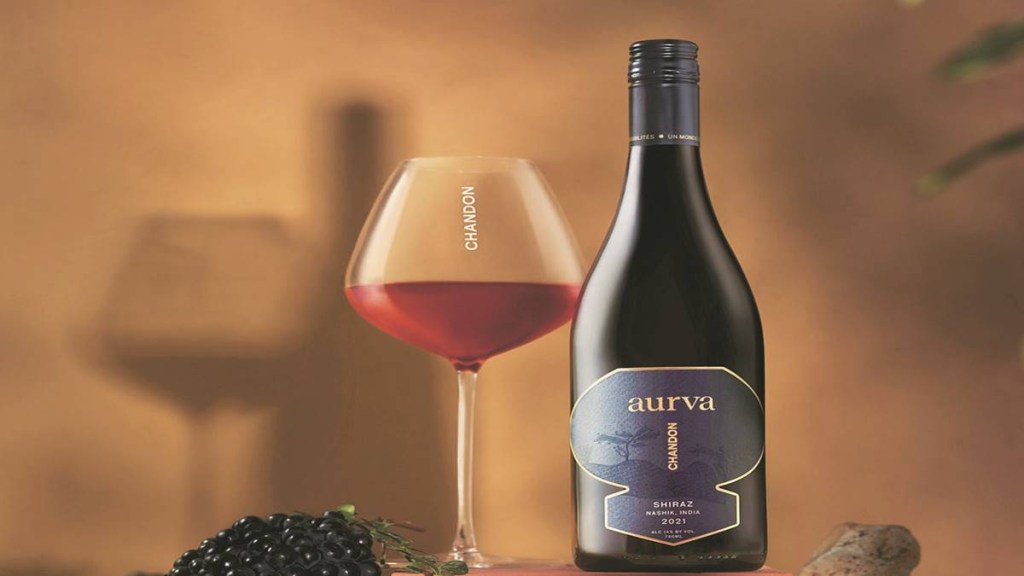Moet Hennessy India, part of French luxury group LVMH, has extended its Chandon spirits label in India to the still wines segment with the launch of Chandon Aurva (Aurva means ‘of the earth’ in Sanskrit), a new red wine crafted from 100% Shiraz grapes, meticulously handpicked in the Nashik region of Maharashtra. Arnaud de Saignes, president, Chandon (LVMH), and Ipsita Das, MD, Moet Hennessy India, speak about the Indian wine debut, growing appetite for made-in-India wines and more in an interview with Vaishali Dar. Edited excerpts:
How different is Chandon Aurva from your existing portfolio in terms of vision?
Arnaud de Saignes (AS): The vision of our founder Robert-Jean de Vogüé and his oenologist Renaud Poirier are as relevant today as it was 60 years ago. We are always yearning to craft wines differently. We keep searching for new terroirs and new expressions for our wines.

Ipsita Das (ID): Our expertise in Shiraz is the genesis from where the idea of Aurva began to form. Chandon Aurva is a remarkable red wine crafted from 100% Shiraz grapes, meticulously handpicked in the Nashik region. The distinct part of curating Chandon Aurva is the harmonious duet between Kaushal Khairnar, our head winemaker in India, who is also the youngest of Chandon’s chefs de caves, and our Australian winemaking director, Dan Buckle, a master in the art of Shiraz winemaking. Together, they have curated a wine that reflects the best of both the worlds.

Aurva is a tribute to Nashik. The intention is not only to shine a spotlight on Nashik’s craftsmanship but also to invite people to elevate their palates and embrace another homegrown premium wine offering from the Moet Hennessy India portfolio.
India is predominantly a brown spirits market. But is there a growing appetite for made-in-India wines?
ID: The Indian consumer is looking to experiment and try newer categories and this is enabling a change in the historical consumption patterns. While wine consumption has traditionally been relatively low compared to other spirits, there’s a notable shift in preferences, especially among urban and younger consumers, who are increasingly embracing wines. India’s overall consumption of spirits and wines is on the rise, with wines experiencing faster growth compared to more mature spirit categories. Despite the progress, the wine market is still relatively nascent compared to spirits, emphasising the importance of exploring strategies to expand the market and consumer base in the coming years.
The Indian wine market expanded to reach a substantial size of $444 million in 2022. It grew by 19% in volume compared to the previous year. The growth is reflected across most price segments. There is also a growing appetite for domestically produced wines.
There’s a discernible change in consumer preferences towards drier and more complex wines, signifying an evolving appreciation for still wine as a versatile beverage suitable for various occasions.
Do issues like taxation, inter-state policies, bottle inconsistency and currency fluctuations pose a challenge to your growing wine business in India?
ID: The alco-bev industry is a complex business ecosystem with state policy governance. As an organisation, we work with the respective regulations. Given that Chandon is the only ‘Maison’ to have a winery in India and the fact that we proudly make our wines in India, import duty policies and custom taxation impact us less.
Is it true that more and more young Indians are now looking for approach, affordability and sustainability in their wine choices? What is Chandon’s approach to this?
AS: Chandon Aurva is strategically designed to cater to specific consumer preferences and evolving trends in the wine market. It caters to individuals who appreciate the finer aspects of wine, including its terroir, craftsmanship and unique character, as well as those who are willing to invest in quality and are curious about diverse wine experiences.
ID: There is a notable trend among young Indians to ‘drink less but better’. This shift in consumer preferences aligns with global trends and has been a driving force behind Chandon’s considerable growth. The demand for Chandon wines has predominantly emanated from metro cities and select tier 1 and 2 cities, reflecting the interest of the urban and young consumer base. Indians are increasingly appreciating products that are not only made in India, but also those that actually celebrate the craftsmanship of our region.
Aurva takes inspiration from this land of rich cultural heritage. At Chandon India, we are highly engaged in restoring biodiversity and sharing our sustainable practices with the communities near our winery. We share, transmit and propose, and we are effectively empowering villagers near our estate, deploying education programmes and capacity building on all the important aspects related to water, plantation, economic significance and ecological importance to create a self-sustaining ecosystem. We have embarked on a transformational journey for our lands and for our communities since the inception of Chandon more than 60 years ago and in all our six properties.
Did Indian viticulture witness a resurgence during the pandemic as consumers explored wines across categories and price brackets? Did it affect the brand’s wine sales in India?
ID: Indian viticulture experienced a resurgence as consumers explored wines across various categories and price brackets. The lockdowns and restrictions led many individuals to experiment with their choices around food and wine. This trend was noticeable among urban consumers, who had more time to explore and appreciate different wines. There is an increasing India sentiment that resonates with brands focused on bringing regional craftsmanship and expertise to life. For Chandon, this shift in consumer behaviour did have an impact on the sales in India. The brand saw increased demand for its wines, particularly among consumers who were eager to experiment with wines and expand their drinking repertoire.








